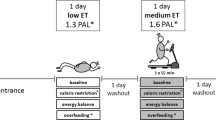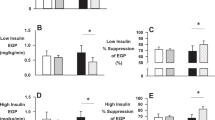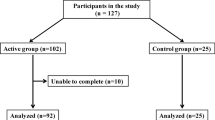Abstract
Background:
The extent to which exercise-induced changes to postprandial metabolism are dependant on the associated energy deficit is not known.
Objective:
To determine the effects of exercise, with and without energy replacement, on postprandial metabolism.
Design:
Each subject underwent three 2-day trials in random order. On day 1 of each trial subjects rested (control), walked at 50% maximal oxygen uptake to induce a net energy expenditure of 27 kJ kg−1 body mass (energy-deficit) or completed the same walk with the net energy expended replaced (energy-replacement). On day 2 subjects completed an 8.5-h metabolic assessment. For 3 days prior to day 2, subjects consumed an isocaloric diet, avoided planned exercise (apart from exercise interventions) and alcohol.
Subjects:
A total of 13 overweight/obese men (age: 40±8 years, body mass index: 31.1±3.0 kg m−2).
Measurements:
Postprandial triglyceride, insulin, glucose, non-esterified fatty acid and 3-hydroxybutyrate concentrations and substrate utilization rates were determined.
Results:
Energy-deficit lowered postprandial triglyceride concentrations by 14 and 10% compared with control and energy-replacement (P<0.05 for both). Energy-deficit increased postprandial 3-hydroxybutyrate concentrations by 40 and 19% compared with control and energy-replacement (P<0.05 for both). Postprandial insulin concentrations were 18 and 10% lower for energy-deficit and energy-replacement compared with control and 10% lower for energy-deficit than energy-replacement (P<0.05 for all). Postprandial fat oxidation increased by 30 and 14% for energy-deficit and energy-replacement compared to control and was 12% higher for energy-deficit than energy-replacement (P<0.05 for all).
Conclusion:
Exercise with energy replacement lowered postprandial insulinaemia and increased fat oxidation. However an exercise-induced energy deficit augmented these effects and was necessary to lower postprandial lipaemia.
This is a preview of subscription content, access via your institution
Access options
Subscribe to this journal
Receive 12 print issues and online access
$259.00 per year
only $21.58 per issue
Buy this article
- Purchase on Springer Link
- Instant access to full article PDF
Prices may be subject to local taxes which are calculated during checkout




Similar content being viewed by others
References
Zilversmit DB . Atherogenesis: a postprandial phenomenon. Circulation 1979; 60: 473–485.
Cohn JS . Postprandial lipemia: emerging evidence for atherogenicity of remnant lipoproteins. Can J Cardiol 1998; 14: 18B–27B.
Frayn KN . Insulin resistance, impaired postprandial lipid metabolism and abdominal obesity. A deadly triad. Med Princ Pract 2002; 11: 31–40.
Boquist S, Hamsten A, Karpe F, Ruotolo G . Insulin and non-esterified fatty acid relations to alimentary lipaemia and plasma concentrations of postprandial triglyceride-rich lipoproteins in healthy middle-aged men. Diabetologia 2000; 43: 185–193.
Tsuchihashi K, Hikita N, Hase M, Agata J, Saitoh S, Nakata T et al. Role of hyperinsulinemia in atherosclerotic coronary arterial disease: studies of semi-quantitative coronary angiography. Intern Med 1999; 38: 691–697.
Yki-Jarvinen H . Evidence for a primary role of insulin resistance in the pathogenesis of type 2 diabetes. Ann Med 1990; 22: 197–200.
Gill JMR, Herd SL, Tsetsonis NV, Hardman AE . Are the reductions in triacylglycerol and insulin levels after exercise related? Clin Sci (London) 2002; 102: 223–231.
Hansen K, Shriver T, Schoeller D . The effects of exercise on the storage and oxidation of dietary fat. Sports Med 2005; 35: 363–373.
Tsetsonis NV, Hardman AE . Reduction in postprandial lipemia after walking: influence of exercise intensity. Med Sci Sports Exerc 1996; 28: 1235–1242.
Gill JMR, Hardman AE . Postprandial lipemia: effects of exercise and restriction of energy intake compared. Am J Clin Nutr 2000; 71: 465–471.
Stubbs RJ, Sepp A, Hughes DA, Johnstone AM, King N, Horgan G et al. The effect of graded levels of exercise on energy intake and balance in free-living women. Int J Obes Relat Metab Disord 2002; 26: 866–869.
Pomerleau M, Imbeault P, Parker T, Doucet E . Effects of exercise intensity on food intake and appetite in women. Am J Clin Nutr 2004; 80: 1230–1236.
Bruce RA, Kusumi F, Hosmer D . Maximal oxygen intake and nomographic assessment of functional aerobic impairment in cardiovascular disease. Am Heart J 1973; 85: 546–562.
American College of Sports Medicine. Guidelines for Exercise Testing and Prescription,6th edn. Lippincott Williams and Wilkins: Philidelphia, 2000.
FAO/WHO/UNU. Energy and Protein Requirements.Report of a joint FAO/WHO/UNU expert consultation. World Health Organization Technical Report Series, 1985.
Department for Environment Food and Rural Affairs. Estimates of Food Consumption and Energy and Nutrition Intakes in the UK in 2002–03. HMSO: London, 2004,pp 3–4.
Borg GA . Perceived exertion: a note on ‘history’ and methods. Med Sci Sports 1973; 5: 90–93.
Gore CJ, Withers RT . Effect of exercise intensity and duration on postexercise metabolism. J Appl Physiol 1990; 68: 2362–2368.
Laforgia J, Withers RT, Shipp NJ, Gore CJ . Comparison of energy expenditure elevations after submaximal and supramaximal running. J Appl Physiol 1997; 82: 661–666.
Sedlock DA, Fissinger JA, Melby CL . Effect of exercise intensity and duration on postexercise energy expenditure. Med Sci Sports Exerc 1989; 21: 662–666.
Lipid Research Clinics Program Manual of Laboratory Operations.DHEW Publication No. (NIM) 78, 1975.
Matthews DR, Hosker JP, Rudenski AS, Naylor BA, Treacher DF, Turner RC . Homeostasis model assessment: insulin resistance and beta-cell function from fasting plasma glucose and insulin concentrations in man. Diabetologia 1985; 28: 412–419.
Frayn KN . Calculation of substrate oxidation rates in vivo from gaseous exchange. J Appl Physiol 1983; 55: 628–634.
Flatt JP, Ravussin E, Acheson KJ, Jequier E . Effects of dietary fat on postprandial substrate oxidation and on carbohydrate and fat balances. J Clin Invest 1985; 76: 1019–1024.
Melanson EL, Donahoo WT, Dong F, Ida T, Zemel MB . Effect of low- and high-calcium dairy-based diets on macronutrient oxidation in humans. Obes Res 2005; 13: 2102–2112.
Votruba SB, Atkinson RL, Hirvonen MD, Schoeller DA . Prior exercise increases subsequent utilization of dietary fat. Med Sci Sports Exerc 2002; 34: 1757–1765.
Melanson EL, Sharp TA, Seagle HM, Donahoo WT, Grunwald GK, Peters JC et al. Resistance and aerobic exercise have similar effects on 24-h nutrient oxidation. Med Sci Sports Exerc 2002; 34: 1793–1800.
Kiens B, Richter EA . Utilization of skeletal muscle triacylglycerol during postexercise recovery in humans. Am J Physiol 1998; 275: E332–E337.
Casey A, Mann R, Banister K, Fox J, Morris PG, Macdonald IA et al. Effect of carbohydrate ingestion on glycogen resynthesis in human liver and skeletal muscle, measured by (13)C MRS. Am J Physiol Endocrinol Metab 2000; 278: E65–E75.
Rothman DL, Magnusson I, Katz LD, Shulman RG, Shulman GI . Quantitation of hepatic glycogenolysis and gluconeogenesis in fasting humans with 13C NMR. Science 1991; 254: 573–576.
Gill JMR, Hardman AE . Exercise and postprandial lipid metabolism: an update on potential mechanisms and interactions with high-carbohydrate diets (Review). J Nutr Biochem 2003; 14: 122–132.
Gill JMR, Al Mamari A, Ferrell WR, Cleland SJ, Sattar N, Packard CJ et al. Effects of a moderate exercise session on postprandial lipoproteins, apolipoproteins and lipoprotein remnants in middle-aged men. Atherosclerosis 2006; 185: 87–96.
Koutsari C, Karpe F, Humphreys SM, Frayn KN, Hardman AE . Exercise prevents the accumulation of triglyceride-rich lipoproteins and their remnants seen when changing to a high-carbohydrate diet. Arterioscler Thromb Vasc Biol 2001; 21: 1520–1525.
Gill JMR, Al Mamari A, Ferrell WR, Cleland SJ, Perry CG, Sattar N et al. Effect of prior moderate exercise on postprandial metabolism in men with type 2 diabetes: heterogeneity of responses. Atherosclerosis 2007; 194: 134–143.
Koeslag JH, Noakes TD, Sloan AW . The effects of alanine, glucose and starch ingestion on the ketosis produced by exercise and by starvation. J Physiol 1982; 325: 363–376.
Seidell JC, Muller DC, Sorkin JD, Andres R . Fasting respiratory exchange ratio and resting metabolic rate as predictors of weight gain: the Baltimore Longitudinal Study on Aging. Int J Obes Relat Metab Disord 1992; 16: 667–674.
Marra M, Scalfi L, Covino A, Esposito-Del Puente A, Contaldo F . Fasting respiratory quotient as a predictor of weight changes in non-obese women. Int J Obes Relat Metab Disord 1998; 22: 601–603.
Zurlo F, Lillioja S, Esposito-Del Puente A, Nyomba BL, Raz I, Saad MF et al. Low ratio of fat to carbohydrate oxidation as predictor of weight gain: study of 24-h RQ. Am J Physiol 1990; 259: E650–E657.
Wareham NJ, van Sluijs EM, Ekelund U . Physical activity and obesity prevention: a review of the current evidence. Proc Nutr Soc 2005; 64: 229–247.
Sinaiko AR, Steinberger J, Moran A, Hong CP, Prineas RJ, Jacobs Jr DR . Influence of insulin resistance and body mass index at age 13 on systolic blood pressure, triglycerides, and high-density lipoprotein cholesterol at age 19. Hypertension 2006; 48: 730–736.
Kekalainen P, Sarlund H, Laakso M . Long-term association of cardiovascular risk factors with impaired insulin secretion and insulin resistance. Metabolism 2000; 49: 1247–1254.
Cartee GD, Young DA, Sleeper MD, Zierath J, Wallberg-Henriksson H, Holloszy JO . Prolonged increase in insulin-stimulated glucose transport in muscle after exercise. Am J Physiol 1989; 256: E494–E499.
Dengel DR, Galecki AT, Hagberg JM, Pratley RE . The independent and combined effects of weight loss and aerobic exercise on blood pressure and oral glucose tolerance in older men. Am J Hypertens 1998; 11: 1405–1412.
Acknowledgements
This work was supported by TENOVUS Scotland. We thank Dr Nicholas Barwell for clinical assistance with subject screening and on experimental study days.
Author information
Authors and Affiliations
Corresponding author
Rights and permissions
About this article
Cite this article
Burton, F., Malkova, D., Caslake, M. et al. Energy replacement attenuates the effects of prior moderate exercise on postprandial metabolism in overweight/obese men. Int J Obes 32, 481–489 (2008). https://doi.org/10.1038/sj.ijo.0803754
Received:
Revised:
Accepted:
Published:
Issue Date:
DOI: https://doi.org/10.1038/sj.ijo.0803754
Keywords
This article is cited by
-
Determinants of the postprandial triglyceride response to a high-fat meal in healthy overweight and obese adults
Lipids in Health and Disease (2021)
-
Whey protein consumption following fasted exercise reduces early postprandial glycaemia in centrally obese males: a randomised controlled trial
European Journal of Nutrition (2021)
-
Energy replacement diminishes the postprandial triglyceride-lowering effect from accumulated walking in older women
European Journal of Nutrition (2020)
-
Effects of thirty and sixty minutes of moderate-intensity aerobic exercise on postprandial lipemia and inflammation in overweight men: a randomized cross-over study
Journal of the International Society of Sports Nutrition (2016)
-
Postprandial lipemic and inflammatory responses to high-fat meals: a review of the roles of acute and chronic exercise
Nutrition & Metabolism (2016)



